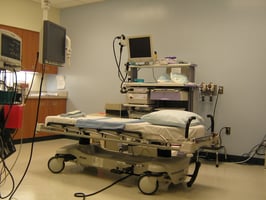Ambulatory Surgery Centers (ASCs) are required by the Centers for Medicare & Medicaid Services...
Top 10 Challenges in Converting OBSs to ASCs
As more procedures migrate to the outpatient setting and Medicare expands the list of approved procedures for Ambulatory Surgery Centers (ASCs), many physicians are seeking to convert their existing Office-Based Surgery Suites (OBSs) into Medicare-certified ASCs. While the incentives are real—especially improved reimbursement and expanded procedural offerings—the path to ASC licensure and certification is not always straightforward.
Some OBSs were originally designed with future conversion in mind, but many were not. Even for those that were, evolving codes, stricter interpretations, and the physical limitations of existing facilities can make the transition surprisingly complicated. Below are the top 10 challenges we encounter when converting OBSs to ASCs, based on our design team's experience across a range of ambulatory care projects.
1. Compliance with Medicare Conditions for Coverage
Many OBSs are physically and operationally integrated into physician office spaces. Medicare, however, requires ASCs to be distinct and separately defined entities. This often means creating new fire rated walls, modifying spaces to meet functional requirements, revising entries, and sometimes building additions to achieve the necessary separation between ASC functions and office operations.
2. Fire and Life Safety Upgrades
ASCs must meet NFPA 101 Life Safety Code requirements for Ambulatory Health Care Occupancies. These include fire-rated construction, smoke compartmentation, compliant egress ways, fire alarms, nurse call systems, medical gases, sprinkler coverage, and emergency electrical systems—many of which may not be present in typical OBS facilities.
3. Base Building Challenges
Existing building conditions frequently pose obstacles to ASC conversion. Common issues include undersized elevators, non-compliant corridor widths, and lack of space for essential infrastructure such as generators or medical HVAC equipment.
4. Upgrading Procedure Rooms to FGI Standards
Procedure rooms in an OBS often don’t meet ASC design standards for room size, clearance, or finishes. Modifications may include enlarging rooms or doors, upgrading surfaces for infection control, and improving environmental controls—all of which can trigger broader facility upgrades. Providing proper scrub sinks and surgical lighting may also be concerns.
5. Limited Space for Ancillary Services
OBSs typically lack the support spaces required for ASC operations, such as required toilet rooms, decontamination and sterile processing areas, staff locker rooms or showers, and adequate clean and equipment storage. Creating space for these services within an existing building often requires layout overhauls or compromises in efficiency.
6. HVAC and Environmental Control Systems
Office-type HVAC systems generally aren’t designed to meet the more stringent conditions required in ASCs, such as proper airflows, filtration, non-aspirating diffusers, unidirectional airflow, and specific temperature and humidity ranges. Retrofitting these systems can involve significant redesign and replacement.
7. Medical Gas Infrastructure
Introducing piped medical gases—particularly oxygen and vacuum systems—into existing walls and ceilings can be a major challenge. Dedicated rooms must also be identified for gas manifolds and vacuum pumps, which often don’t exist in the original layout.
8. Electrical Infrastructure
ASCs require robust electrical systems that include emergency power for critical systems, isolated power for wet procedure locations, and sufficient capacity for specialized medical equipment. Retrofitting this infrastructure while maintaining code compliance adds cost and complexity.
9. Phased Construction Within an Occupied Facility
Many physicians hope to continue performing procedures during the conversion process. Phased construction within an occupied facility presents significant logistical and infection control challenges, especially when maintaining clean separation between construction and patient care areas.
10. Capital Investment vs. Reimbursement Potential
While the financial upside of ASC conversion can be substantial, the capital investment is not insignificant. From design and permitting to construction and equipment upgrades, costs can escalate quickly. A detailed financial analysis—including expected case volume, payer mix, and depreciation schedule—is critical to determining whether conversion is a wise long-term investment.
Converting an OBS to an ASC can unlock real value—but only with a full understanding of what it takes to get there. If you're considering a conversion, we recommend a feasibility study that includes a thorough existing conditions analysis, code and regulatory review, a plan test-fit, and early engineering input. Hardaway|Sziabowski Architects specializes in navigating these complex transitions with clarity and precision. Let us know if we can help you with you facility conversion.



